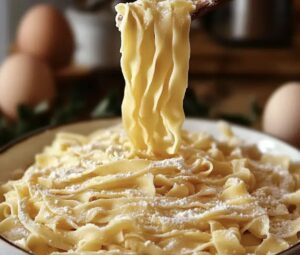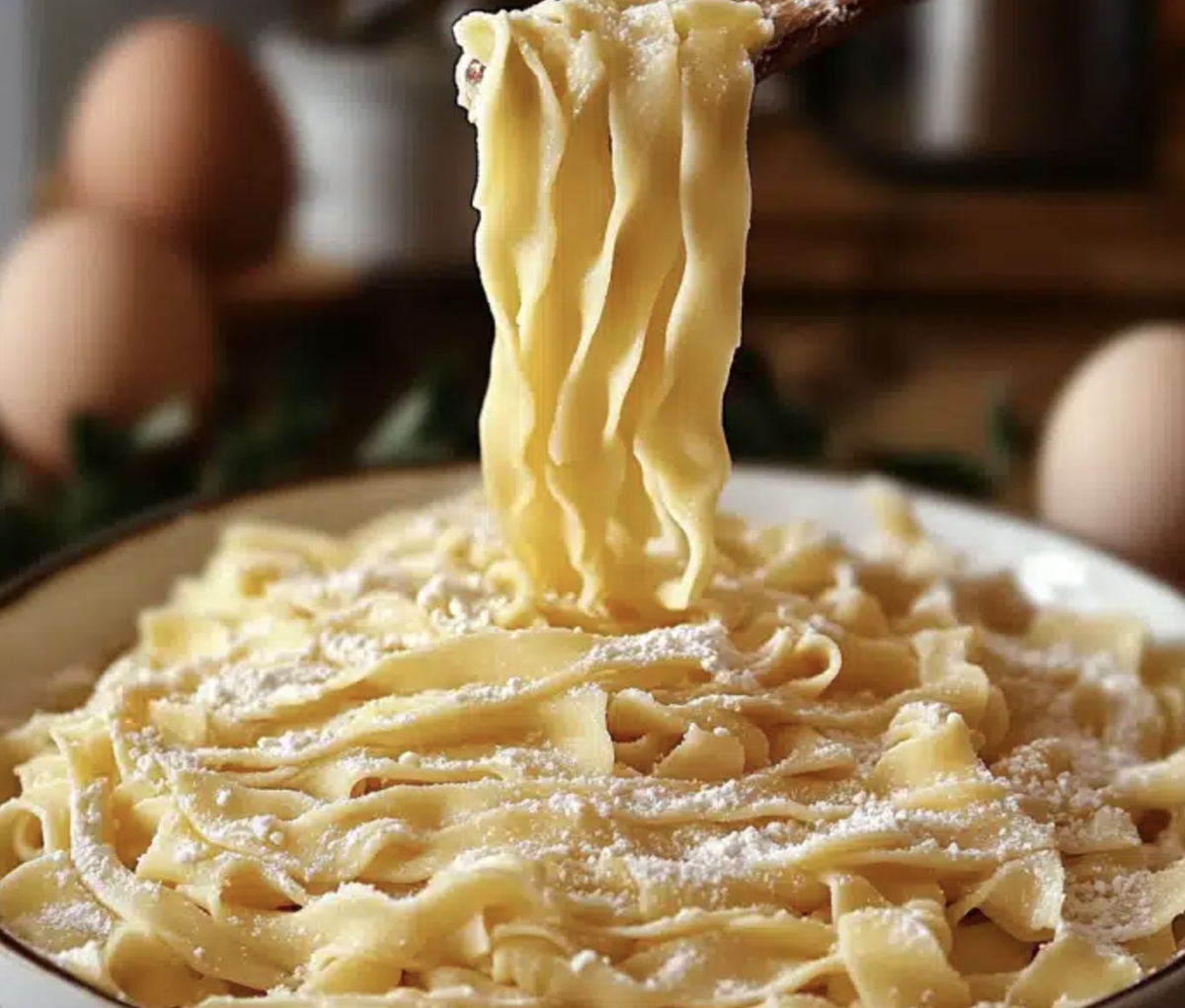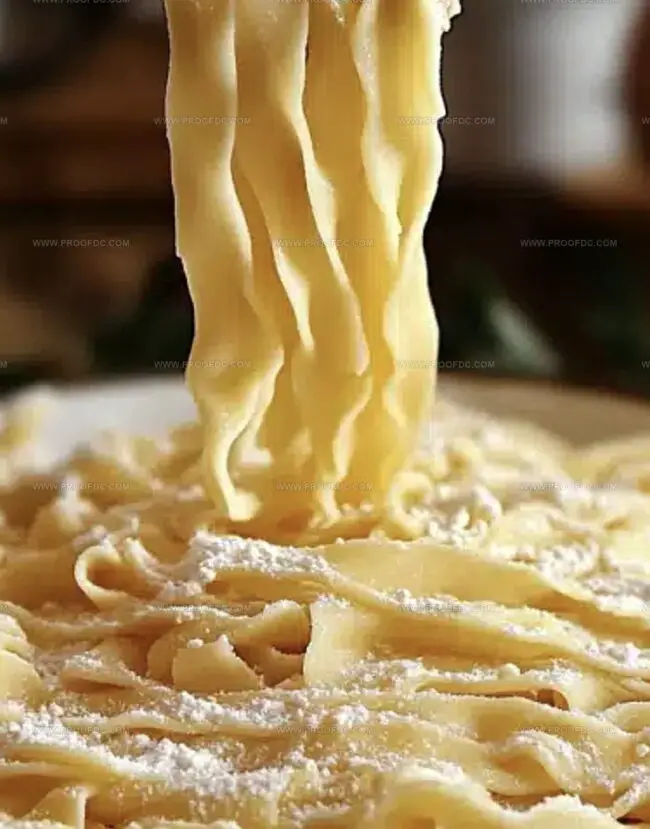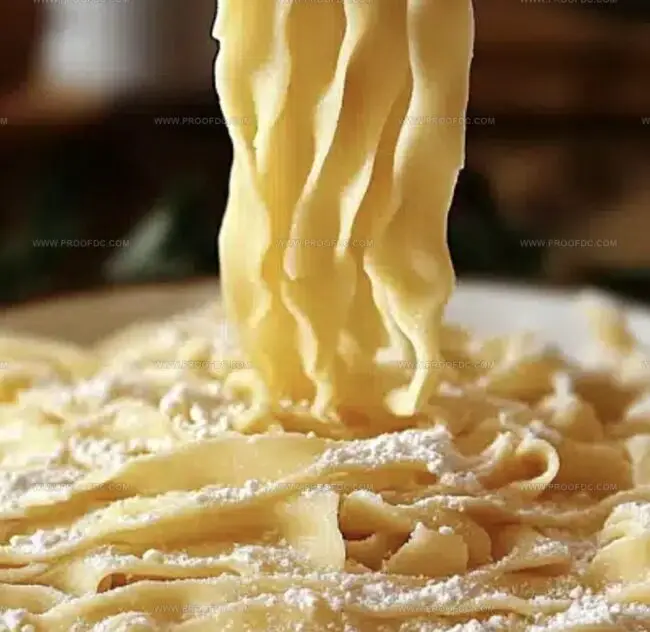The Coziest Homemade Egg Noodles Recipe for Family Dinners
Crafting delectable homemade egg noodles can bring unexpected joy to your kitchen adventures.
These silky strands of pure comfort emerge from simple ingredients anyone can master.
Transforming basic pantry staples into something magical and delicious.
Soft, tender noodles promise a culinary experience that beats store-bought versions every single time.
Whisking eggs and flour becomes an intuitive dance of creativity and skill.
Learning this technique connects you to generations of home cooks who understood the magic of handmade pasta.
With minimal effort, you can create something truly special that will spark conversations and smiles around the dinner table.
Grab your apron and let’s make noodle-making an exciting new skill in your cooking repertoire.
Reasons To Love Homemade Egg Noodles
Ingredients List For Homemade Egg Noodles
Flour Based Ingredients:Liquid and Binding Ingredients:Optional Garnish and Preparation Ingredients:How To Cook Homemade Egg Noodles Step By Step
Step 1: Whip Up the Dough Base
Grab a spacious mixing bowl and toss in flour and salt. Make a cozy crater in the center of the flour mountain. Crack eggs right into this flour nest. Gently wake up those eggs with a fork, slowly pulling flour from the edges until everything transforms into a shaggy dough cluster.
Ingredients:Transfer this messy mixture onto a flour-dusted countertop. Start massaging and folding the dough with your hands. Work it like a baker on a mission for 8-10 minutes until the texture becomes smooth and stretchy. If the dough feels too dry, splash a tiny water droplet. If it’s sticky, dust with extra flour.
Wrap the dough in plastic or tuck under a clean kitchen cloth. Let it chill and relax at room temperature for half an hour. This magical resting time helps gluten unwind and makes rolling easier.
Step 2: Shape Your Noodle Canvas
Slice the dough into two friendly portions for easier handling. Roll out each section on a flour-sprinkled surface. Create sheets as thin or thick as your heart desires.
Grab a sharp knife or pizza cutter. Transform these dough sheets into beautiful ribbons. Sprinkle a bit of flour to keep them from getting clingy.
Step 3: Transform Ribbons into Deliciousness
Fill a large pot with water or broth. Bring to a rolling boil and add a pinch of salt. Gently slide your handmade noodles into the bubbling liquid. Let them dance and cook for 2-4 minutes until they reach perfect tenderness. Drain quickly and serve immediately.
Helpful Pointers For Homemade Egg Noodles
How To Store And Reheat Homemade Egg Noodles Right
Best Foods To Serve With Homemade Egg Noodles
Fun Ways To Switch Up Homemade Egg Noodles
Questions And Answers About Homemade Egg Noodles
Absolutely! Homemade egg noodles contain fewer preservatives and additives. You control the ingredients, ensuring a fresher, more nutritious pasta that’s free from processed chemicals.
Yes! You can easily roll and cut noodles by hand using a rolling pin and sharp knife. Traditional cooks have been making noodles this way for generations, so don’t worry about special equipment.
The perfect dough should feel smooth and elastic, not crumbly or sticky. When you knead it, it should spring back slightly when pressed and hold together without falling apart. If it’s too dry, add water; if too sticky, add flour.
Definitely! After cutting your noodles, dust them with flour and lay them flat on a baking sheet. Freeze until solid, then transfer to a freezer bag. They’ll stay fresh for up to 3 weeks, giving you a quick homemade pasta option anytime.
Print
Homemade Egg Noodles Recipe
- Total Time: 55 minutes
- Yield: 4 1x
Description
Delightful Homemade Egg Noodles weave culinary magic into simple pasta perfection. Silky strands crafted with basic ingredients promise comfort and flavor you’ll savor with each delectable bite.
Ingredients
Main Ingredients:
- 3 large eggs
- 2 cups (250 g) all-purpose flour
Seasoning:
- ½ teaspoon salt
Liquid Ingredient:
- 12 tablespoons (180 milliliters) water (as needed)
Instructions
- Prepare the foundational mixture by sifting flour and salt into a spacious mixing vessel, creating a pristine landscape of dry ingredients.
- Excavate a central crater in the flour terrain, gently depositing eggs into this well. Delicately whisk the eggs, gradually drawing surrounding flour particles into a cohesive mass until a rustic dough emerges.
- Transfer the nascent dough onto a dusted work surface, commencing a rhythmic kneading ritual. Manipulate the dough with firm, deliberate motions for approximately 8-10 minutes, developing its structural integrity.
- Detect the dough’s moisture balance – if excessively parched, introduce minuscule water increments; if overly tacky, dust with additional flour until achieving a supple, uniform consistency.
- Envelop the dough in protective plastic wrap or a clean textile, allowing it a tranquil resting period of 30 minutes. This interval permits gluten networks to relax and strengthen.
- Segment the reposed dough into manageable portions, facilitating easier manipulation and rolling.
- Using a rolling implement, transform each dough segment into a thin, uniform sheet, adjusting thickness according to intended culinary application.
- Employ a sharp blade or specialized cutting tool to slice the rolled dough into precise noodle strips, varying width to match desired dish.
- Delicately coat freshly cut noodles with a light flour veil to prevent adhesion.
- Bring a generously salted liquid medium to a vigorous boil, carefully introducing the noodles and cooking until they achieve a tender, al dente texture, typically 2-4 minutes.
- Promptly drain the noodles and serve, celebrating their fresh, homemade essence.
Notes
- Fresh eggs make all the difference in creating rich, golden noodles with exceptional texture and flavor.
- Kneading develops gluten, transforming a shaggy mixture into a smooth, elastic dough that’s perfect for hand-rolled noodles.
- Resting the dough allows flour to fully hydrate, making it easier to roll and preventing tough, chewy results.
- Use semolina or wheat flour for extra protein and a more authentic pasta-like consistency that holds up beautifully in soups and casseroles.
- Gluten-free bakers can substitute all-purpose flour with a blend of rice flour and xanthan gum for similar elastic properties.
- Store uncooked noodles on a lightly floured baking sheet, covered, in the refrigerator for up to two days before cooking.
- Freeze extra noodles flat on a baking sheet, then transfer to a freezer bag for up to three months of meal prep convenience.
- Prep Time: 5 minutes
- Cook Time: 30 minutes
- Category: Breakfast, Lunch, Dinner
- Method: Boiling
- Cuisine: Italian
Nutrition
- Serving Size: 4
- Calories: 178
- Sugar: 0.3 g
- Sodium: 125 mg
- Fat: 4.2 g
- Saturated Fat: 1.3 g
- Unsaturated Fat: 2.9 g
- Trans Fat: 0 g
- Carbohydrates: 30.6 g
- Fiber: 1.4 g
- Protein: 6.6 g
- Cholesterol: 126 mg




Jenna Stewart
Head Chef & Recipe Innovator
Expertise
Farm-to-Table Cooking; Seasonal Menu Development; Visual Plating Techniques; Flavor Layering and Simple Prep Hacks.
Education
The Culinary Institute of America, Hyde Park, NY
Jenna Stewart is the inventive spirit behind many of our standout dishes at Pro of Delicious Creations. A proud graduate of The Culinary Institute of America, she built her skills mastering both classic recipes and fresh, modern twists.
Now, Jenna celebrates the beauty of seasonal, local ingredients, often sourced from her garden and nearby markets, to create recipes that are bursting with flavor yet easy to follow. When she’s not experimenting in the kitchen, Jenna loves exploring nature on hikes and discovering new treasures at local co-ops.